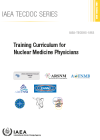The Section focuses on fostering the use of nuclear medicine and diagnostic imaging procedures for both diagnosis and therapy.
Nuclear Medicine and Diagnostic Imaging Section
What is diagnostic imaging?
Medical imaging refers to several different technologies that are used to study the human body for the purpose of diagnosing, monitoring, or treating medical conditions. These technologies provide different information about the area of the body that is being studied or treated, related to a possible disease, injury, or the effectiveness of medical treatment.
It is divided into two major types: those that have an excellent resolution and provide precise anatomical details e.g., computed tomography (CT) and magnetic resonance (MR) and those that generate a representation of the function of organs or tissues being analysed also known as Molecular Imaging such as Single Photon Emission Computed Tomography (SPECT) and Positron Emission Tomography (PET).
Imaging technologies are fast-growing and evolving disciplines that allow the visualization, characterisation and quantification of anatomical lesions or biologic events that occur at early stages of disease. The past two decades have seen the development of hybrid imaging, which combines the anatomical and functional images such as SPECT/CT, PET/CT and PET/ MR . Thus, generating a powerful tool for the diagnosis of several health conditions, in particular non-communicable diseases such as cardiovascular diseases, cancer, neurodegenerative disorders and diabetes which are the leading causes of mortality worldwide and that represent a burden on health care systems.
What is nuclear medicine?
Nuclear medicine involves the administration into the body of small and safe amounts of radiopharmaceuticals, which are compounds containing radioactive material that can be used for diagnosis and treatment. Thus, the nuclear medicine physician is the medical specialist that has the proper medical and scientific knowledge to safely use open sources of radioactive material for such purposes. Modern nuclear medicine plays an essential role in achieving personalised (or precision) medicine, therefore allowing the selection of specific treatment, appropriate to individual patients’ condition or predisposition towards a disease. It can therefore address risk assessment, diagnosis, treatment monitoring and radionuclide therapy related to the unique characteristics of the individual, aiming to enhance the quality of life and public health, and contributing to the attainment of the United Nations Sustainable Development goal 3 -Good health and wellbeing for all at all ages.
What are the objectives of the Nuclear Medicine and Diagnostic Imaging Section?
The long-term objective of the Section’s work is to provide comprehensive support to establish or strengthen the practice of nuclear medicine and radiology within the context of appropriate use, safety, and quality of clinical practice.
To this end, the Section supports Member States in all phases or stages of implementation of nuclear medicine and radiology department including:
- Advising how to justify a new department, modality, or application.
- Providing guidance on the planning and setting up of the right department, adequate to demographic and epidemiological needs
- Supporting the continuing professional development of staff.
- Promoting the appropriate use of each type of medical imaging (the right test for the right patient).
- Advising how to adhere to international and national standards and regulations, including radiation protection.
- Encouraging the implementation of comprehensive, patient-centred quality management systems in nuclear medicine (QUANUM) and radiology (QUAADRIL).
- And encouraging low and middle-income countries (LMICs) to be part of Coordinated Research Projects (CRPs) and contribute to solving gaps in medical evidence.
As part of the support for continuous professional development the Section organises webinars, international conferences such as international Conference on Molecular Imaging and Clinical PET–CT (IPET), International Conference on Integrated Medical Imaging in Cardiovascular Diseases (IMIC) and International Virtual Conference on Theranostics (IVICT). It also organises technical and expert meetings and prepares technical and scientific publications related to nuclear medicine and radiology, that are published by the IAEA or in peer review journals.








